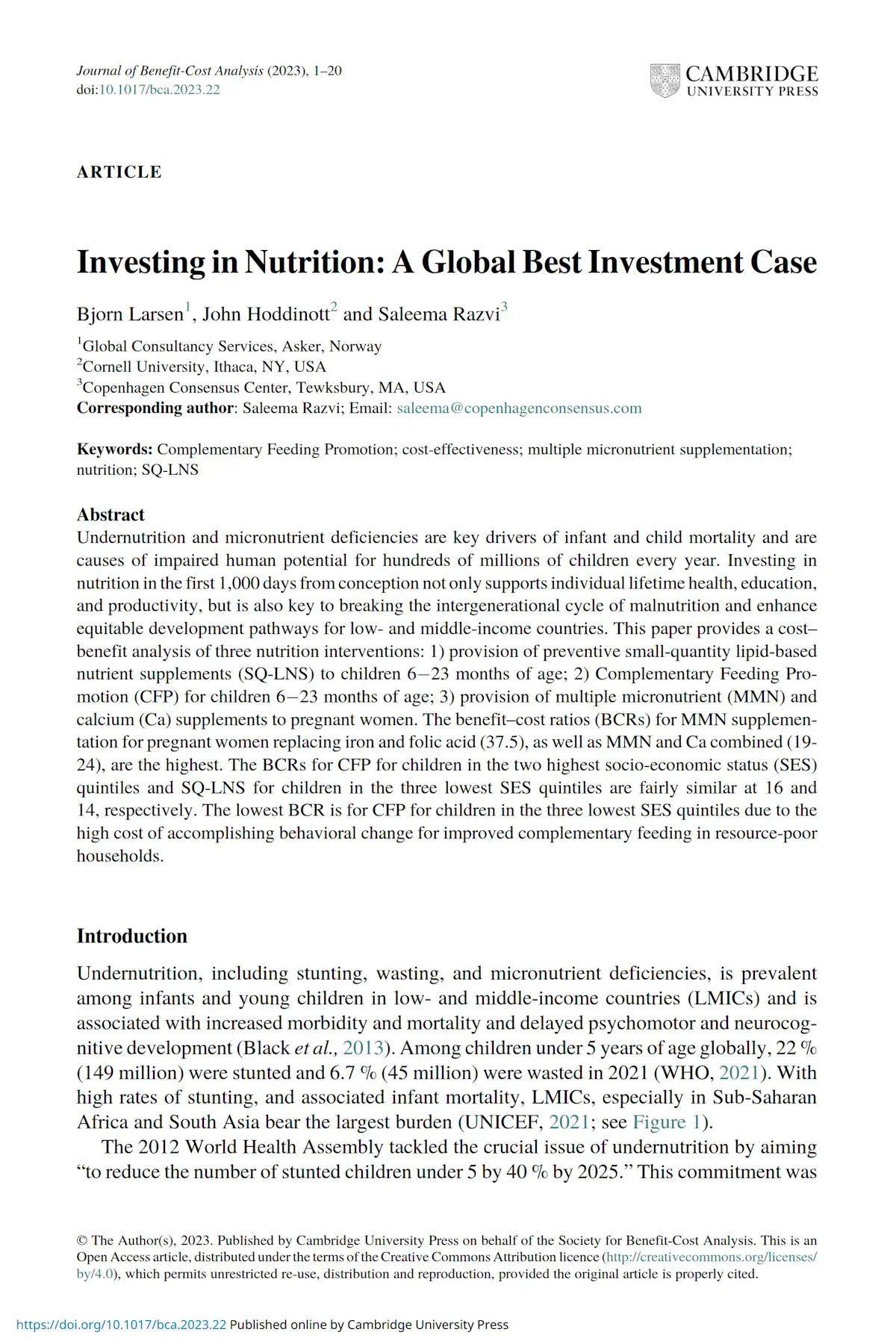Halftime for SDGs: Nutrition
Best Investment Paper
Undernutrition and micronutrient deficiencies are key drivers of infant and child mortality and are causes of impaired human potential for hundreds of millions of children every year. Investing in nutrition in the first 1,000 days from conception not only supports individual lifetime health, education, and productivity, but is also key to breaking the intergenerational cycle of malnutrition and enhance equitable development pathways for low- and middle-income countries.
A decade ago, Bhutta et al (2013) presented a comprehensive update of a package of evidence-based interventions to address undernutrition and micronutrient deficiencies in women and children. The package consisted of ten interventions. Four are for pregnant women and six are for children: periconceptional folic acid supplementation or fortification, maternal balanced energy protein supplementation, maternal calcium (Ca) supplementation, multiple micronutrient (MMN) supplementation in pregnancy, promotion of breastfeeding, appropriate complementary feeding, vitamin A and preventive zinc supplementation in children 6–59 months of age, management of severe acute malnutrition (SAM), and management of moderate acute malnutrition (MAM).
Since then, Keats et al (2021) presented a new update of the evidence of effective interventions, including strengthened evidence on the effectiveness of MMN supplementation. The update also reviews the evidence of some emerging interventions, such as preventive small-quantity lipid-based nutrient supplements (SQ-LNS) for children 6-23 months.
In light of the emerging evidence on the effectiveness of preventive SQ-LNS and strengthened evidence on MMN supplementation over the last decade, this paper provides a cost-benefit analysis of preventive SQ-LNS, the more traditional complementary feeding promotion (CFP), and two supplement interventions for pregnant women. Specifically, benefits and costs of three nutrition interventions are assessed in this paper:
- Provision of preventive small-quantity lipid-based nutrient supplements (SQ-LNS) to children 6−23 months of age.
- Complementary Feeding Promotion (CFP) for children 6−23 months of age.
- Provision of MMN and Ca supplements to pregnant women.
The two first interventions target the cohort of children born in the 40 low- and lower middle-income (LI-LMI) countries with the highest prevalence of stunting among children under five years of age.
Within these countries the preventive SQ-LNS intervention targets the children in the three lowest quintiles of socio-economic status (SES), as for instance defined in Demographic and Health Surveys (DHS). This group has disproportionately high stunting prevalence rates and limited resources to provide adequate complementary food to their children.
The CFP intervention targets the same group of 40 LI-LMI countries. Within these countries we model the intervention for two groups: i) children in the same group as the preventive SQ-LNS, but with a cash transfer to make adequate complementary feeding affordable; ii) children in the two highest quintiles of SES, but without a cash transfer because households in this group have far more resources than in the three lowest quintiles of SES. We are not assessing provision of preventive SQ-LNS to children in the two highest quintiles of SES because a large share of these children is at low risk of becoming stunted
Quantified benefits of these two interventions are reduced prevalence of stunting and reduced mortality.
The third intervention replaces iron and folic acid (IFA) with MMN and additionally provides Ca supplements. The intervention targets 40% of pregnant women annually in low- and lower middle-income countries. This is the percentage of pregnant women that currently take IFA supplementation (36 million women) mainly delivered through antenatal care (ANC) services. Quantified benefits are reductions in still births, low birth weight (LBW) births, premature births (PB), and maternal mortality.
MMN supplementation for pregnant women replacing IFA, as well as MMN and Ca combined, have the highest benefit-cost ratios (BCRs). The BCRs for CFP for children in the two highest SES quintiles and SQ-LNS for children in the three lowest SES quintiles are fairly similar at 16 and 14, respectively. The lowest BCR is for CFP for children in the three lowest SES quintiles due to the high cost of accomplishing behavioral change for improved complementary feeding in resource poor households.
Table: Annual benefits and costs of nutrition interventions
| Benefit | Cost | BCR | |
| Preventive SQ-LNS for children 6−23 months in the three lowest SES quintiles |
44,515 |
3,248 |
13.7 |
| CFP for children 6−23 months in the three lowest SES quintiles |
27,988 |
3,748 |
7.5 |
| CFP for children 6−23 months of age in the two highest SES quintiles |
12,160 |
765 |
15.9 |
| MMN for pregnant women (replacing IFA) |
3,162 |
84 |
37.5 |
| Adding Ca for pregnant women (w/o maternal mortality reduction) |
2,426 |
216 |
11.2 |
| Adding Ca for pregnant women (w/ maternal mortality reduction) |
4,009 |
216 |
18.6 |
| MMN and Ca for pregnant women (w/o maternal mortality reduction) |
5,588 |
300 |
18.6 |
| MMN and Ca for pregnant women (w/ maternal mortality reduction) |
7,171 |
300 |
23.9 |
Note: Base case BCRs with 8% discount rate.
The final peer-reviewed published article can be found here:


